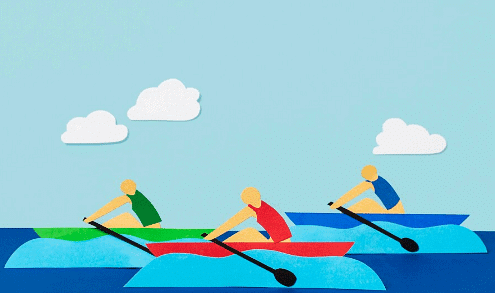Important Tips: Boats and Streams | Quantitative Aptitude for SSC CGL PDF Download
Downstream
When the boat's direction aligns with the flow of water, it is referred to as downstream.
Upstream
When the boat's direction opposes the flow of water, it is termed as upstream.

Type 1: Tips and Tricks for Boats and Streams questions on Finding Speed of Boat
Boats and Streams Tips and Trick and Shortcuts
Speed of the boat in still water = 1/2 (Downstream speed + Upstream speed)
Downstream speed = Speed of boat in still water + Speed of stream
Upstream speed = Speed of boat in still water – Speed of stream
Q1: A man rows a boat at 12 km/h along the stream and 8 km/h against the stream. Find the speed of the boat in still water.
(a) 12km/hr
(b) 10km/hr
(c) 15km/hr
(d) 8km/hr
Ans: (b)
Downstream speed of the boat = 12 km/h
Upstream speed of the boat = 8 km/h
Speed of the boat in still water = 1/2*(Downstream speed + Upstream speed)
= 1/2 (12 + 8)
= 10 km/h
 |
Download the notes
Important Tips: Boats and Streams
|
Download as PDF |
Type 2: Tips and Tricks to Find the Speed of Stream
Tips and Trick and Shortcuts for Boats and Streams
Speed of stream = 1/2 *(Downstream speed – upstream speed)
Speed downstream = (u + v ) km/hr.
Speed upstream = (u – v ) km/hr.
Q1: A boat whose speed in 15 km/hr in still water goes 30 km downstream and it takes 4 hours 30 minutes to come back. Find the speed of the stream?
(a) 25km/hr
(b) 15m/hr
(c) 20km/hr
(d) 5km/hr
Ans: (d)
Let the speed of the stream = x
Therefore, speed downstream = 15 + x
Speed upstream = 15 – x
30/(15+x) + 30/(15-x) = 4hr 30 min
30/(15+x)+ 30/(15-x) = 9/2
On solving we get
x = 5km/hr
Type 3: Using Man’s Still Water Speed Calculate Stream’s Speed
Q1: A sailor can row 6 km/h in still water. It takes him twice as long to row up as to row down the river. Find the speed of the stream.
(a) 6 km/ hr
(b) 5 km/ hr
(c) 3 km/ hr
(d) 2 km/ hr
Ans: (d)
Let sailor’s speed in upstream = x
Downstream speed = 2x (As given in the question, his downstream speed is twice of upstream speed)
Man’s speed in still water = 1/2 (Upstream speed + Downstream speed)
= 1/2 (x + 2x) = 3x/2
3x/2 = 6 (sailor can row 6 km/h in still water)
x = 4 km/hr
Therefore, upstream speed = x = 4 km/hr
Downstream speed = 2x = 2 * 4 = 8 km/hr
Speed of stream = 1/2* (Downstream speed – Upstream speed)
= 1/2 (8 – 4)
= 2 km/ hr
|
315 videos|182 docs|185 tests
|
FAQs on Important Tips: Boats and Streams - Quantitative Aptitude for SSC CGL
| 1. What is the difference between downstream and upstream in the context of boats and streams? |  |
| 2. How does the current affect a boat's speed when going downstream? |  |
| 3. What strategies can be used to navigate a boat efficiently when going upstream? |  |
| 4. Is it easier to control a boat when going downstream or upstream? |  |
| 5. What factors should be considered when determining the direction to travel in a stream or river? |  |


























